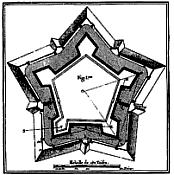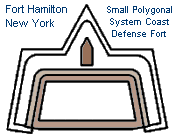A system of fortification was a very general manner of tracing
the enceinte of a front of fortification to include certain elements that
produced certain defensive effects. There were four basic systems of
fortification: Circular system which employed curved arcs to enclose a front
of fortification; the Tenaille system which employed alternating salient
and re-entering angles; the bastion system which used the archetypical bastion
trace to produce mutually supporting elements within a front; and, finally,
the polygonal system which traced the enceinte rampart along lines that followed
the exterior sides of the fortified polygon and relied on casemated caponnieres
for flank defense of fronts of fortification.
Circular System
 The circular system was primarily employed in the design of
small seacoast fortifications to position the greatest number of guns on
the shortest practicable linear development of a front. In this system the
scarp wall was traced on the circumference of a circular arc that was The circular system was primarily employed in the design of
small seacoast fortifications to position the greatest number of guns on
the shortest practicable linear development of a front. In this system the
scarp wall was traced on the circumference of a circular arc that was
 usually cut
off and flattened into a right line, traced with a projecting salient angle
at the gorge. In some cases the circular system was employed for fronts facing
a river or harbor channel while the other fronts were traced on the bastion
system. While a circular system front could mount a large number of guns,
their fire was diverging and relative few guns could be concentrated to give
an overwhelming fire against a single target, but the form was better adapted
to maintaining fire on a target warship as it passed through the channel
protected by the fortification. usually cut
off and flattened into a right line, traced with a projecting salient angle
at the gorge. In some cases the circular system was employed for fronts facing
a river or harbor channel while the other fronts were traced on the bastion
system. While a circular system front could mount a large number of guns,
their fire was diverging and relative few guns could be concentrated to give
an overwhelming fire against a single target, but the form was better adapted
to maintaining fire on a target warship as it passed through the channel
protected by the fortification.
Tenaille System
 The tenaille
system broke each front of fortification into a series of salient and re-entering
angles that could be traced as regular indented (cremaillere) lines or
alternating 60º salient and 90º or 120º re-entering angles.
Each salient produced two faces that were vulnerable to enfilading ricochet
fire along with wide sectors without fire immediately in front of the salients;
in most cases flanking defense of the ditch was defective. The linear development
of the rampart was usually out of proportion with the interior space which
was greatly reduced by the re-entering angles, though this difficulty could
be mitigated by reducing the number of salients and employing obtuse angles
for both salients and re-enterings, but this type of modification also produced
a very irregular enceinte. The tenaille
system broke each front of fortification into a series of salient and re-entering
angles that could be traced as regular indented (cremaillere) lines or
alternating 60º salient and 90º or 120º re-entering angles.
Each salient produced two faces that were vulnerable to enfilading ricochet
fire along with wide sectors without fire immediately in front of the salients;
in most cases flanking defense of the ditch was defective. The linear development
of the rampart was usually out of proportion with the interior space which
was greatly reduced by the re-entering angles, though this difficulty could
be mitigated by reducing the number of salients and employing obtuse angles
for both salients and re-enterings, but this type of modification also produced
a very irregular enceinte.
Bastion System
 The bastion system of fortification was by far the most widely
employed system from the end of the fifteenth to the middle of the nineteenth
centuries. Each front of fortification in the bastion system included two
demi-bastions (one on each extremity of the front) connected by a curtain
which formed the enceinte. These demi-bastions were joined at the angles
of the fronts to form fully developed bastions consisting of two faces and
two flanks. The enceinte itself was shielded by a variety of outworks including,
most prominently, demi-lunes and an enveloping covered way. These outworks
could also be covered by even more outworks that added depth to the defense
and increased the period of time necessary for a besieging army to compel
a fortification to capitulate. When a bastion system front was carefully
profiled the arrangement of the linear elements eliminated all dead ground
on the exterior side of the enceinte and insured that the fortification was
protected by crossing columns of fire. The bastion system of fortification was by far the most widely
employed system from the end of the fifteenth to the middle of the nineteenth
centuries. Each front of fortification in the bastion system included two
demi-bastions (one on each extremity of the front) connected by a curtain
which formed the enceinte. These demi-bastions were joined at the angles
of the fronts to form fully developed bastions consisting of two faces and
two flanks. The enceinte itself was shielded by a variety of outworks including,
most prominently, demi-lunes and an enveloping covered way. These outworks
could also be covered by even more outworks that added depth to the defense
and increased the period of time necessary for a besieging army to compel
a fortification to capitulate. When a bastion system front was carefully
profiled the arrangement of the linear elements eliminated all dead ground
on the exterior side of the enceinte and insured that the fortification was
protected by crossing columns of fire.
Polygonal System
 In the polygonal
system the enceinte rampart closely followed the exterior sides of the fortified
polygon and eliminated the salients of the bastion system that were vulnerable
to ricochet and reverse fire. Fronts of fortification were lengthened by
relying on artillery rather than musket fire for flanking defense and placing
artillery for flank defense in a casemated caponniere at the mid-point of
each front where it could fire to the right and left along the front of the
enceinte rampart. Increasing the artillery armament of the enceinte rampart
to oppose a besieging army's own siege batteries was one of the primary objects
of the polygonal system. This was accomplished by both increasing the length
of each front of fortification and protecting artillery in enceinte casemates.
Musket fire for defense of the ditch was obtained by establishing crenellated
scarp walls that were either fully or partially detached from the rampart.
These improvements lead to an excessive use of exposed masonry walls that
were vulnerable to breaching by distant artillery fire. In the polygonal
system the enceinte rampart closely followed the exterior sides of the fortified
polygon and eliminated the salients of the bastion system that were vulnerable
to ricochet and reverse fire. Fronts of fortification were lengthened by
relying on artillery rather than musket fire for flanking defense and placing
artillery for flank defense in a casemated caponniere at the mid-point of
each front where it could fire to the right and left along the front of the
enceinte rampart. Increasing the artillery armament of the enceinte rampart
to oppose a besieging army's own siege batteries was one of the primary objects
of the polygonal system. This was accomplished by both increasing the length
of each front of fortification and protecting artillery in enceinte casemates.
Musket fire for defense of the ditch was obtained by establishing crenellated
scarp walls that were either fully or partially detached from the rampart.
These improvements lead to an excessive use of exposed masonry walls that
were vulnerable to breaching by distant artillery fire. |